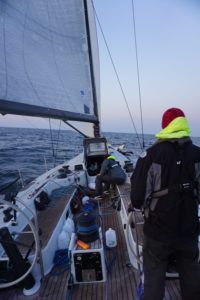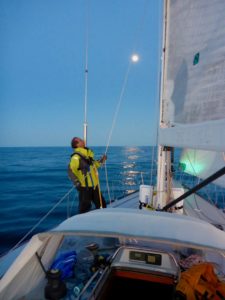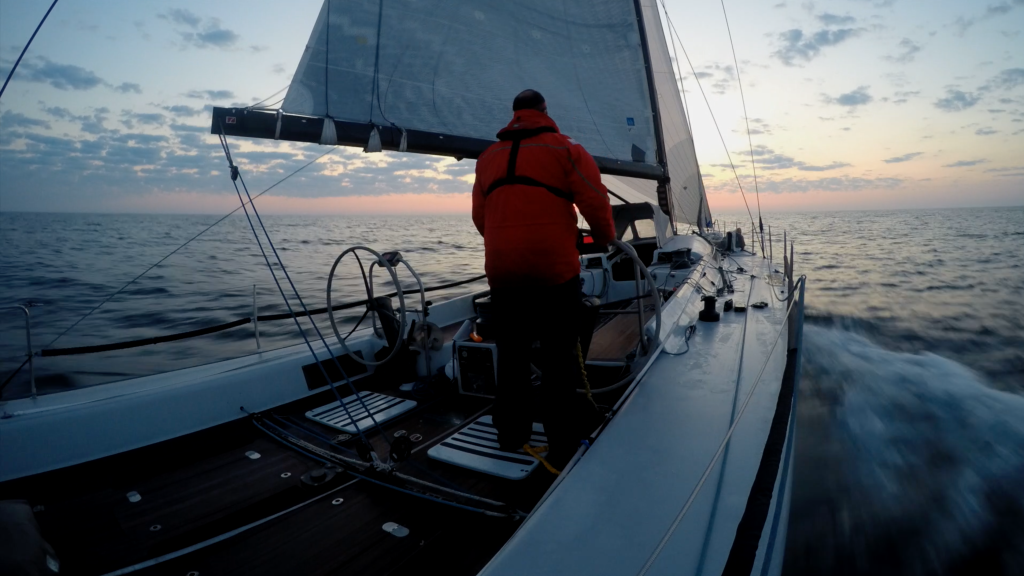I was convinced I needed to buy a boat. I’d spent the last two years skippering club boats as far afield as they were allowed to go; another year of membership simply wouldn’t help me grow as a sailor. I needed to get offshore to progress and to get offshore I needed to buy a boat!
WRONG!! Here I am three years later and I’m doing as much (if not more) offshore sailing than my continued employment allows. You can too! If you want to get offshore experience this series will teach you where to find offshore sailing passages; whether you’re an owner who wants to get blue water experience as crew or a sailor who wants a taste of life at sea. By the end of the series, instead of wondering if you can get offshore experience you’ll be trying to decide between the many options for blue water voyaging!
Before we start, are you sure you don’t know a skipper you trust who’d like to take you offshore with them? You’re NOT sure? Be more vocal about your interest in sailing offshore; especially around sailors and skippers you trust! After all the extensive research I did into finding the best offshore passages it has been word of mouth has brought me my best offshore sailing experiences. Don’t be shy: talk to sailors you trust and listen to what they have to say!
Solo Watches?
Are you prepared to stand a solo watch offshore? At night while everyone else aboard is asleep below? If you’re ready for the challenge of standing a solo watch some of these types of voyages will be much more appealing than others. If you’re not ready for solo watches then some offshore opportunities are off the table; don’t worry though, there are still plenty to choose from. “Like what” you say? I’m glad you asked!
Take an Offshore Certification Course
A handful of sailing schools offer offshore sailing instruction. A certified instructor will take you and a few other students on a qualifying offshore passage during which you learn and demonstrate the knowledge and skills of the curriculum. These are expensive ($3000 to $6000) but you get to go on a trip where your education is the primary concern. You can be certain the instructor will be one of the school’s most experienced instructors and an expert sailor.
For $4200 the Maryland School of Sailing has an offshore passagemaking course from Norfolk, VA to Bermuda or Bermuda back to Norfolk, VA.
Pros
- You know what they’re going to cover and that it’s approved by a governing body
- Solo watches only if you want them (and can convince the instructor)
- Given by schools: easy to sign up, straightforward payments
- You get the berth you pay for
- Departure and return date known well in advance
Cons
- There could be prerequisite courses that you haven’t taken
- The other students skill can add lot or detract from your education
- Usually limited to “well used” boats though they’re generally rigorously prepared
- Limited flexibility to accommodate weather
Paid Offshore Voyages
Some experienced skippers sell berths on their offshore passages to sailors looking to gain experience. These skippers usually have at least a bit of celebrity to find enough customers without being affiliated with a school or governing body. These skippers will likely be the most accomplished ocean sailors you’ll ever meet with heaps of knowledge to impart and plenty of sea tales to share. These passages can definitely break the “offshore certification course” mould of a summer passage about a week long. This novelty, celebrity and expertise comes at a cost.
If you can wait two seasons you can join John Kretschmer for an offshore passage up to and possibly including an Atlantic crossing (more options will be presented later in the series). I was planning to do that except I found 5000nm of offshore experience before his next berth was available. I guess that makes me impatient.
Pros
- If you pay for it, wait for it and do the research you can get a world class skipper
- Possible solo watches if you want them (ask before you buy!)
- You get your choice of location and other aspects of the experience (fast boat, similar boat to what you want, etc)
- You get the berth you pay for
- Departure and return date known well in advance
Cons
- Expensive
- Can fill up or be crowded boats
- Really need to do your research
- Limited flexibility to accommodate weather
Owner Skippered Deliveries
When cruisers are faced with a longer passage they often take on extra crew to help out. Sometimes they are even required to do so by their insurance. This is the most varied type of offshore passage opportunity out there. They might cover all your costs or charge you a fee. This could be their first offshore passage or their 100th. The range of skills levels that these cruisers will be looking for in crew varies widely: they might be looking for a experienced offshore captain all the way to somebody to keep their regular crew company on watch.
I joined a very difficult delivery skippered by the owner and have been skeptical since then. I’ve had good experience with owner deliveries since then but I think that’s because of my skepticism; not in spite of it.
Pros
- The boat is a known quantity
- Often all the comforts of home (by the skipper’s standard)
- Usually get to choose your weather window
- The variety might be an opportunity to get you exactly the experience you desire
Cons
- Probably requires solo watches
- The boat isn’t on a schedule which could be a problem if you are
- Widest variation in skipper skill
- Difficult to judge skipper skill – you must be very careful
- If you get the sense that you won’t get along or are worried about competence via electronic communications strongly reconsider
Professionally Skippered Deliveries
 Delivery skippers get paid to move boats around the world by owners who don’t have the time or experience to do it themselves. These skippers aren’t rich folk and will be willing to have you aboard if you’re looking to be compensated by experience and can convince them you’ll be an asset to the voyage. You (and the skipper) usually roll the dice on the boat and weather and are on a tight schedule so the sound of the diesel may never cease during the trip. Some, if not all, of your expenses will be covered by the skipper (then passed on to the owner).
Delivery skippers get paid to move boats around the world by owners who don’t have the time or experience to do it themselves. These skippers aren’t rich folk and will be willing to have you aboard if you’re looking to be compensated by experience and can convince them you’ll be an asset to the voyage. You (and the skipper) usually roll the dice on the boat and weather and are on a tight schedule so the sound of the diesel may never cease during the trip. Some, if not all, of your expenses will be covered by the skipper (then passed on to the owner).
These trips can be very demanding for crew. Especially given opportunities to sail with these skippers seem to pop up when something is amiss. I found a majority of the first trips with delivery skippers I sail with because of last minute problems such as “the autopilot doesn’t work so we’ll be hand steering for four days offshore” or “we have to get this boat to the boat show by Wednesday but there is a gale in our way.” If you’re ready this can be exactly what you’re looking for otherwise you’re in for a rough couple of days.
Halcyon Yacht Delivery will consider you as delivery crew for a £20 processing fee so long as you’re “capable of competently standing a solo watch at night”.
Pros:
- Experienced Skipper & Crew
- Often have your own cabin
- Owners that can afford a skipper can afford more expensive boats
- If you get invited back there will be multiple opportunities per year
Cons:
- Solo watches probably mandatory
- You’re on the clock and may smash into bad weather
- Learning is not the priority
- Often scheduled last minute
- More expensive does not mean “more things working”
- Electrical system shuts down 3x/day. No autopilot. Head not working: use bucket.
Offshore Rallies
One tool owners use to make difficult passages is a cruising rally. These are put together by an organizer and consist of many boats making an offshore passage at the same time. The idea is safety in numbers:participating in a rally allows the owner to lean on the organizer and other owners during passage preparations. On passage the crews can communicate with one another on radio nets and, in theory, rely on each other if problems arise.
For inexperienced crew the organizer is a safety net. The organizer authors and enforces safety standards as well as safety practices. The organizer evaluates the preparedness of participating boats and crews. They help pick the weather window and route. They use established cruising routes at safe times of year.
On the other hand less experienced skippers and crews are the ones looking for this assistance; of all the offshore passage types you’ll generally find the least experienced skippers and crews participating in rallies. I find this concerning and so do other experienced sailors: “The very last thing I’d want when beginning a 2000 mile crossing, is upwards of a 100 boats setting out at the same time, on about the same course and headed for the same place as I am, mostly being driven by amateurs who are too afraid to make the crossing on their own. That’s exactly the opposite of safe sailing to me.” – Captain Andrew of SkippingStoneSailing.com.
The World Cruising Club seems to have cornered the market on rallies, fortunately they have a multitude of rallies to choose from throughout the year.
Pros:
- Oversight of boats and skippers
- Will motor through calms
- These are longer trips, often ocean crossings
- Approximate dates known well in advance
Cons:
- Probably solo watches
- Roughly speaking: least skilled skippers of all options
- All levels of boats participate
- Schedule can lead them to head out in less than ideal conditions
Offshore Races

Owners need a lot of crew to run amateur offshore racing programs and are often willing to try out enthusiastic sailors without offshore experience. Racing offshore is often more demanding than other offshore sailing. You sail the boat hard 24×7. The start doesn’t wait for a comfortable weather window. There is no motoring through calms. Foredeck work and sail changes at night.
The boat will be crowded but also loaded with experienced sailors you can learn from. They’ll teach you because then you can sail the boat faster. The safety requirements of offshore races are rigorous and extensive.
A fully crewed raceboat has sufficient safety margin to take crew on speculatively; they’ll have enough crew onboard to fill in if one or two crew can’t contribute offshore (perhaps completely incapacitated by sea sickness). If you’re truly an offshore novice or in any way worried about seasickness this is a luxury you’ll be hard pressed to find on any of the other offshore passage types. The plentiful crew gives offshore racing the lowest barrier to entry for novice offshore sailors.
Offshore racing is how I got started sailing offshore. Between the race preparations, the race to Bermuda and the return delivery my sailing abilities grew at a breakneck pace. The experience cost me only time and I’d strongly recommend offshore racing as the best way to rapidly grow your offshore sailing skills; even, and perhaps especially, for offshore novices.
Pros
- Lowest barrier to entry for getting experience offshore
- Most Crew Skill: Plenty of skilled people to learn from
- Race Officers enforce the strictest safety requirements
- Get involved and learn a lot
- Volunteer to update the safety equipment & thru-hull diagram!
- Often (mandatory) opportunities to practice
- Faster boats
- Inexpensive: many skippers cover all expenses
- Dates known well in advance
Cons
- Absolutely no solo watches
- Might only learn a specific position
- Fixed schedule can cause problems:
- Head out into rough weather or
- Your boat doesn’t make the start
- Crowded! Usually hot bunking
- Might sit becalmed for days
Offshore Race Deliveries
Return deliveries from offshore races deserve separate mention. The return delivery is another way racing programs try out potential crew. Offshore race deliveries work out to be an experience somewhere between an offshore race, a rally and a delivery.
When you’re getting started offshore you should favor deliveries after the race. After the race the boat will have completed all of the safety inspections. She’ll have just been put through the rigors of the race. The crew will just have experienced the stretch of water you’ll be transiting. The return delivery is often fully crewed because the race crew hitches a ride back and if it is you won’t stand a solo watch.
The weeks leading up to an offshore race are often very hectic. Every delivery to the start line I have participated in has been without essential sailing things; the boom for example. Caveat empor.
If you’re really opposed to racing the return delivery is another good option for getting offshore that can accommodate offshore novices.
- Do the race then the delivery back!
- Solo watches unlikely
- Race boats are not setup for solo watches
- Sometimes racing deliveries have an even lower bar for experience
- Racing Deliveries have a flexible departure schedule and weather guidance; like rallies
- Be wary of deliveries before the race
Wrapping Up:
See? I told you there are tons of ways to get offshore experience! Whether you’re overwhelmed by the many options or absolutely sure which kind you want to start with next up you need to find a specific offshore passage, boat and skipper. Choose one of these articles and get started!
- Finding and Evaluating Pay to Play Offshore Voyages
- Finding and choosing a skipper to sail offshore with
- Finding and Evaluating a crew spot at an offshore rally, race or race return delivery
Good luck! And see you out there!!
Updated 01-Dec-2019

TJ Very thorough and well thought article. Excellent.
Northeast sailing by the end of the month!
I’m starting this weekend!!! Forecast looks hopeful and if not I have foulies…
http://sonsetmarine.com/offshoretraining-2.aspx